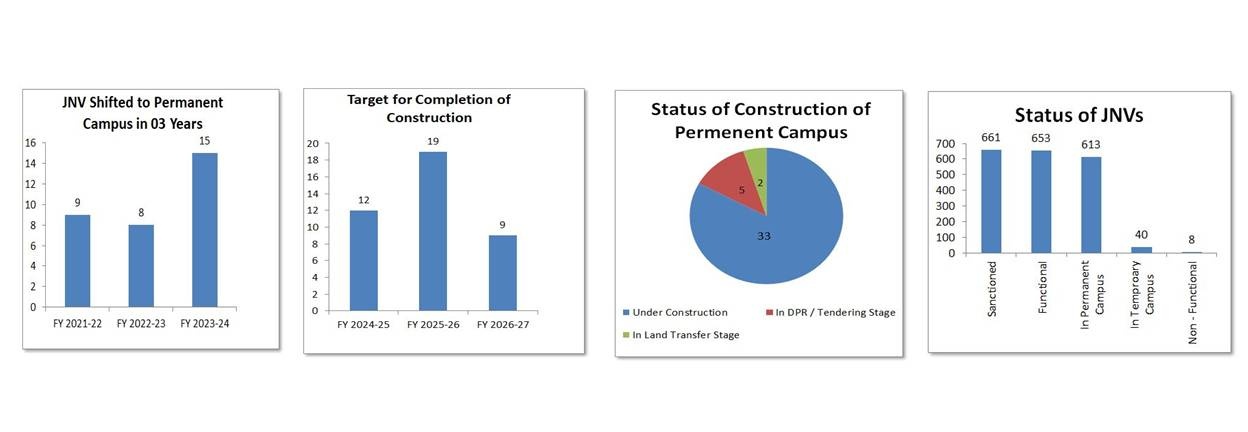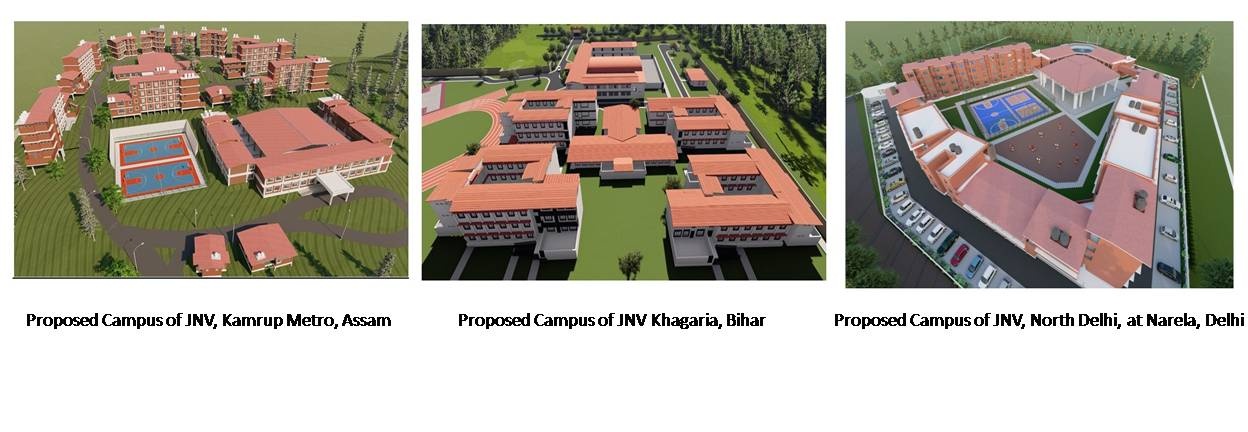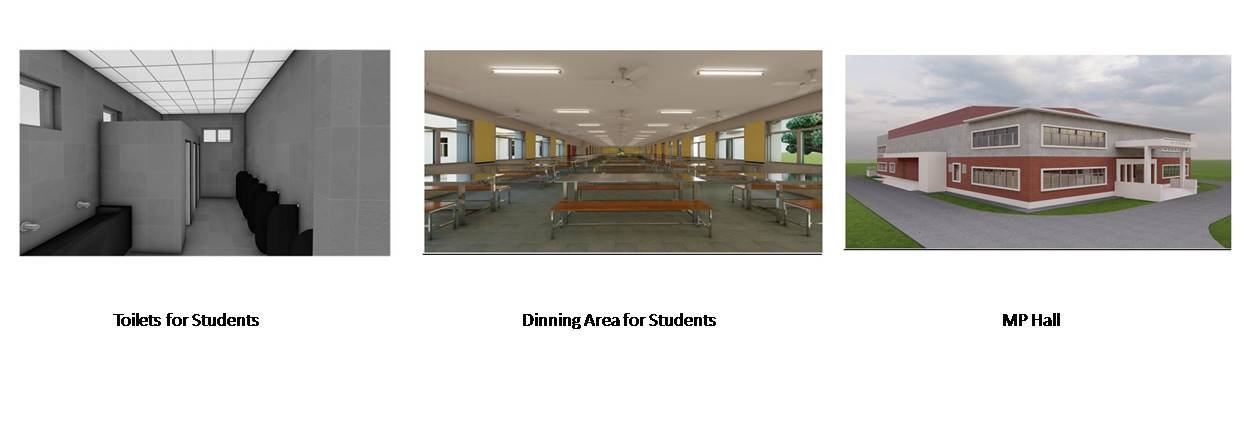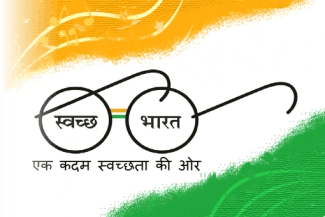1. General
Jawahar Navodaya Vidyalayas are planned to have an identity exclusive to their function; that of a hallowed seat of learning. JNVs are residential schools resembling traditional 'Gurukulas', to which the students develop an inherent and strong sense of belonging and pride. As of the financial year 2023-24, JNVs have been sanctioned for 661 districts, excluding Tamil Nadu. Out of these, 613 JNVs are functional from permanent campus, 40 are functioning from temporary campus, and 8 remain non-operational due to non-availability of land/temporary campus.

2. Infrastructure in JNVs
Construction of permanent campus is taken-up once the land is offered by the State Govt./UT and approved by Ministry of Education, Govt. of India. Typically the infrastructures provided in a Jawahar Navodaya Vidyalayas includes school building, boys & girls dormitories, kitchen and dining facility, residences for faculty and staff with ample open spaces for playing and recreation.
The School Building
The school building provides 14 classrooms to accommodate 40 students each, 4 laboratories, library, Principal & Vice-Principal rooms, administrative and staff rooms with separate sets of toilets for boys, girls and children with special need (CWSN).
The Dormitories for Girls & Boys
The typical strength of Jawahar Navodya Vidyalayas is 560 students with residential facility for all. In a residential school, the students are expected to learn & imbibe healthy habits with self-sufficiency, discipline, dignity of labour and sharing attitude. Their living accommodation, therefore shall induce the right atmosphere besides providing natural light, ventilation, physical and visual spaciousness. The tropical climatic conditions in India are an important consideration in the design of the hostel. Hence, the physical form of the hostel is kept simple but highly efficient from functional point of view. The dormitories (Boys & Girls) comprises of 03-units, each unit accommodating 192 students. Dormitories also have accommodation for housemasters (one for 48 students).
Staff Residences
Principal's residence of Type-V is placed at prominent location near academic zone in the layout for effective control. There is also Vice-Principal residence of Type-IV, 30 staff residences of Type-III for teachers, 13 nos. staff residences of Type-II for administrative and supporting staff. One Guest House equivalent to Type-II is also constructed to cater the visiting staff/inspections.
Kitchen and Dining Hall
A spacious dining hall for 560 students along with kitchen measuring 757 sqm. are provided where all students can take food at a time.
Utilities/Services
Roads, internal pathways, sewerage disposal system, water supply, storm water drain., play Þ eld having a 200/400 meters running track, kho-kho grounds (one each for Boys & Girls) of size 40m. X 30 m. and two basket ball courts of size 40 m. X 30 m., Electric substation, pump house, Security Guard booth, Under Ground Tank of 1.00 lakh ltrs. Capacity and campus boundary wall with main entry gate.
Facilities for children with special needs (CWSN)
All newly constructed JNVs provided with all basic and essential required facilities like barrier free ramp and toilets for Divyang. The old JNVs constructed on old CBRI pattern have also been extended this facility through special drive to make them disabled friendly in tune with the Government's initiative to promote inclusive education in the schools so that physical mobility is not a constraint in pursuit of formal school education among such children.
3. Up-gradation of Design of JNV Building
Considering the modern day requirements, the material, specification, orientation and layout of building has been modified in new design for the JNV building to make JNV buidlings eco-friendly and green buildings to enhance comfort of occupants. The built form of Jawahar Navodaya Vidyalayas is simple, low profile, and vernacular so as not to appear alien and forbidding in its surroundings. The emphasis is only not on the physical form but on its overall relationship with its setting, which is natural and quaint, in keeping with its predominantly rural set-up and an ambience which merges well with the surroundings. For varying climatic and topographical regions, different variations of designs with different roof forms and building materials are adopted.

4. Up-gradation of materials/Superior specifications
In order to have uniformity in constructions, and to ensure assets created are as per present day standard, up graded materials/superior specifications have been adopted as per CPWD norms and local availability. Necessary provisions are being made for buildings in the earthquake zones.
(a) Improvements in Buildings:
- Exposed brick/Stone cladding for external façade of Academic Block.
- Anti-fungal exterior grade water proof weather coat paints for enhanced life.
- Aluminium colour coated/ UPVC windows in place of steel tubular / Z-section windows and ventilators.
- Solid PVC door for Toilet/bath/WC in place of door with Angle/T-iron frame.
- BEE 5 star rated electrical appliances with energy efficient lighting with LED lights.
(b) Improvement of Utilities/Facilities
- Independent lockable storage unit under the bed and provision of Cooler Platform for Desert coolers.
- Modular furniture in the classroom, Library.
- Modular Laboratories.
- Granite flooring / dado in handwash area in place of ceramic tiles.
- Built-in storage for teaching aids in classrooms, Built-in Almirahs /wardrobes in Staff quarters with modular kitchen.
- Up-gradation of internal electrification lighting / power points in Staff quarters as per modern living standards.
(c) Measure to Reduce Leakage/Seepage
- Brick- coba Roof Treatment for waterproofing replaced with sloping roof slab with galvalume sheet for better water/thermal insulation.
- Elimination of Sunken floors and camouflaging of water supply and sanitary line with snap grid false ceiling.
- Elimination of lintel and chhajja/sunshade with extension of floor slab.
(d) Eco-Friendly Measures
- Rain water harvesting system for recharging ground water.
- Use of Green certiÞ ed materials for GRIHA compliance.
- Aerated Cement Concrete (ACC) block/Cellular Concrete (CLC)/brick work/fly-ash bricks or other suitable energy efficient and locally available materials for walls.
- Use of zero VOC paints.
- Use of PPC (Portland Pozzolana Cement) made from fly ash from thermal plants.
- Provision of solar lighting & grid connected roof top solar system.
- Provision of solar water heating system.
- Energy efficient LED lighting/BEE 5 Star rated appliances.
- Use of local stone.
- Use of local plant variants with less water demand.




CONSTRUCTION WORKS DURING THE YEAR 2023-24
- Construction of new Campus Works of Phase-A, 15 nos. of JNVs have been shifted from temporary site to permanent campus.
- Construction of additional works of Phase-B in 12 nos. of JNVs have been completed.
- Construction of permanent campus has been sanctioned/commenced in 01 JNV.
- Construction of additional infrastructure of Phase-B work has been sanctioned/commenced in 15 JNVs.
Conclusion
The infrastructure provided in Jawahar Navodaya Vidyalayas (JNVs) plays a crucial role in enhancing the quality of education and the overall learning experience of students. Well-planned and executed infrastructure provides a conducive learning environment, supports extracurricular activities, and meets the residential needs of students, fostering a holistic development of students. The continuous improvements in JNV infrastructure is made not only to elevate the standard of education but also enable equitable access to quality education facilities for students from rural areas. Sustainable and inclusive construction practices are being prioritized to ensure that JNVs remain resilient, functional, and equipped to meet future educational demands. The commitment to infrastructure excellence will strengthen JNVs’ capacity building to fulÞ ll the mission of nurturing talent and promoting excellence among young learners across India.



